When it comes to heirloom tomatoes, the German Johnson variety stands out for its impressive size, vibrant color, and exceptional flavor. These pink-red beauties are highly coveted by tomato enthusiasts and gardeners alike, making them a staple in many backyard gardens and farmer’s markets.
But what sets German Johnson tomatoes apart from other tomato varieties? In this article, I will share valuable tips and tricks for successfully growing German Johnson tomatoes in your garden. From planting and caring for these plants to harvesting and storing their delicious fruits, you’ll learn everything you need to know to have a thriving German Johnson tomato garden.
Key Takeaways:
- German Johnson tomatoes are a popular heirloom variety known for their large, pink-red fruits.
- They require at least 3 feet of spacing between plants and thrive in humid climates.
- German Johnson tomatoes are indeterminate plants, meaning they continue to produce fruit throughout the growing season.
- These tomatoes have a slightly acidic flavor, making them great for sandwiches and salads.
- German Johnson tomatoes can be saved as seeds for future planting and enjoyed in a variety of recipes.
German Johnson Tomato Characteristics
German Johnson tomatoes are a beefsteak-type heirloom variety with large, pink-red fruits. They have a robust growth habit, reaching heights of up to 6-8 feet. These indeterminate plants continue to produce fruit throughout the growing season, ensuring a bountiful harvest. German Johnson tomatoes offer a slightly acidic flavor, making them a delightful addition to sandwiches and salads. They are also known for their minimal seed content, making them highly desirable for canning.
If you’re considering growing German Johnson tomatoes in your tomato garden, their impressive size, flavor, and versatility make them an excellent choice.
German Johnson Tomato Characteristics
| Traits | Description |
|---|---|
| Fruit Size | Large |
| Fruit Color | Pink-red |
| Growth Habit | Robust, reaching 6-8 feet |
| Type | Heirloom beefsteak |
| Flavor | Slightly acidic |
| Seed Content | Minimal, ideal for canning |
Planting German Johnson Tomatoes
When it comes to planting German Johnson tomatoes, there are a few key steps to ensure your tomato garden thrives. Here’s what you need to know:
1. Start with Healthy Seedlings or Starter Plants
For successful growth, it’s important to begin with healthy German Johnson tomato seedlings or starter plants. Look for plants with strong stems and vibrant green leaves. Avoid plants that appear wilted or show signs of disease.
2. Choose a Sunny Location with Well-Draining Soil
German Johnson tomatoes thrive in full sunlight, so select a location in your tomato garden that receives at least 6-8 hours of direct sunlight each day. Additionally, ensure that the soil is well-draining to prevent waterlogged roots and rot.
3. Space the Plants Appropriately
German Johnson tomatoes are known for their vigorous growth, so it’s important to give them enough space. Plant the seedlings at least 2 feet apart to allow for proper air circulation and room to spread their branches.
4. Plant at the Same Depth as the Containers
When transplanting the German Johnson tomato seedlings, make sure to plant them at the same depth as they were in their containers. This will help establish a strong root system and promote healthy growth.
5. Thoroughly Water and Maintain Regular Watering
After planting, water the German Johnson tomato plants thoroughly to ensure the soil is evenly moist. Throughout the growing season, continue to provide regular watering, especially during dry periods. Be mindful not to overwater, as this can lead to root rot.
An image of a thriving German Johnson tomato plant in a garden setting.
By following these planting guidelines, you’ll be on your way to a successful German Johnson tomato garden. In the next section, we’ll explore essential care tips to keep your plants healthy and productive.
German Johnson Tomato Care
When it comes to caring for German Johnson tomatoes, a little extra attention goes a long way. These robust plants require moderate to high maintenance in order to thrive and produce a bountiful harvest. Here are some essential tips for taking care of your German Johnson tomato plants:
Regular Watering
German Johnson tomatoes have a high water requirement, especially during dry periods. Proper watering is crucial to prevent issues like blossom end rot, a common problem that causes the bottom of the fruit to decay. Keep the soil consistently moist, but not waterlogged, throughout the growing season.
Mulching for Moisture
Mulching around your German Johnson tomato plants can significantly help retain moisture and control weeds. Apply a layer of organic mulch, such as straw or wood chips, around the base of the plants. This will help keep the soil cool and moist, reducing the need for excessive watering and minimizing weed growth.
Pruning for Airflow
While pruning German Johnson tomatoes is not necessary, it can be beneficial to improve airflow and reduce the risk of disease. Remove any suckers that form in the leaf axils, as they can divert energy from fruit production. Additionally, remove any diseased or damaged leaves to promote healthy growth.
Fertilizing with Balance
To ensure optimal growth and fruit development, it’s important to fertilize your German Johnson tomato plants regularly. Use a balanced tomato fertilizer according to the package instructions, providing the necessary nutrients for healthy foliage and robust fruiting. Avoid over-fertilizing, as this can lead to excessive foliage growth at the expense of fruit production.
Vigilance Against Pests
German Johnson tomatoes, like any tomato plants, can be prone to common pests such as aphids and thrips. Keep a close eye on your plants and inspect them regularly for signs of infestation. If you notice any pests, treat them promptly with organic insecticidal soap or other suitable methods, taking care to follow the instructions for safe and effective pest control.
Common Tomato Pests and Treatments
| Pest | Treatment |
|---|---|
| Aphids | Organic insecticidal soap |
| Thrips | Organic insecticidal soap |
| Other common pests | Beneficial insects, such as ladybugs |
In addition to pests, be aware of the potential for disease. German Johnson tomatoes can be susceptible to various tomato diseases such as late blight, early blight, septoria leaf spot, and anthracnose. Practice good garden hygiene by removing any infected plant material and consider using resistant varieties or preventive treatments to minimize the risk.
With proper care and attention, your German Johnson tomato plants will reward you with abundant and delicious harvests. Stay vigilant, provide the right conditions, and your plants will thrive throughout the growing season.
Harvesting German Johnson Tomatoes
After patiently tending to your German Johnson tomato plants, it’s finally time to reap the rewards of your hard work. Harvesting these delicious tomatoes is an exciting milestone in the gardening journey. Here are some tips for harvesting German Johnson tomatoes:
- Wait for full ripeness: German Johnson tomatoes take approximately 70-80 days to reach maturity after transplanting. Keep a close eye on them as they develop, and wait until they have a deep pink color before harvesting. This ensures that they are at their peak flavor and juiciness.
- Gentle harvesting: To harvest German Johnson tomatoes, gently twist or cut the fruits from the vine. Take care not to damage the plant or the surrounding tomatoes. Using a sharp knife or pruning shears can help make clean cuts without causing unnecessary stress to the plant.
German Johnson tomatoes are incredibly versatile in the kitchen. Their juicy, flavorful flesh can be used in various recipes, adding a burst of freshness to your dishes. Here are a few popular ways to enjoy German Johnson tomatoes:
- Delicious sandwiches: Slice German Johnson tomatoes and layer them onto sandwiches for a juicy and flavorful bite. They pair well with a variety of ingredients, such as crisp lettuce, creamy avocado, and savory bacon.
- Refreshing salads: Chop German Johnson tomatoes into bite-sized pieces and toss them into salads for a sweet and tangy burst of flavor. Combine them with leafy greens, cucumber, red onion, and your favorite dressing for a refreshing summer salad.
- Homemade sauces: German Johnson tomatoes are perfect for making homemade tomato sauces. Their rich flavor and minimal seed content make them ideal for creating velvety sauces to enhance pasta dishes or serve as a base for other recipes.
To inspire your culinary creativity, here’s a mouthwatering recipe featuring German Johnson tomatoes:
German Johnson Tomato Bruschetta:
Ingredients:
- 4 ripe German Johnson tomatoes, diced
- 1/4 cup fresh basil leaves, chopped
- 2 cloves garlic, minced
- 2 tablespoons extra-virgin olive oil
- 1 tablespoon balsamic vinegar
- Salt and pepper to taste
- 8 slices of crusty bread, toasted
Instructions:
- In a bowl, combine the diced German Johnson tomatoes, chopped basil, minced garlic, olive oil, and balsamic vinegar. Season with salt and pepper to taste.
- Allow the mixture to marinate for at least 15 minutes, allowing the flavors to meld together.
- Once the bruschetta mixture is ready, spoon it generously onto the toasted bread slices.
- Serve as an appetizer or side dish at your next gathering and enjoy the delightful flavors of German Johnson tomatoes.
Now you’re ready to savor the deliciousness of German Johnson tomatoes. Whether you incorporate them into sandwiches, salads, or mouthwatering recipes like bruschetta, these flavorful tomatoes are sure to impress your taste buds.
Companion Plants for German Johnson Tomatoes
When it comes to growing German Johnson tomatoes, companion planting can play a vital role in promoting their growth and overall health. By choosing the right companions, you can enhance the flavor and productivity of these delicious heirloom tomatoes. Here are some suitable companion plants that pair well with German Johnson tomatoes:
Lettuce
Lactuca sativa
Planting lettuce alongside German Johnson tomatoes brings a refreshing element to your garden while providing shade for the tomato plants. Lettuce is a cool-season crop that prefers partial shade, making it the perfect companion to prevent the soil from drying out too quickly. Additionally, the dense foliage of lettuce can help deter pests and weeds.
Basil
Ocimum basilicum
Basil is not just a popular culinary herb; it also makes an excellent companion plant for German Johnson tomatoes. The aromatic leaves of basil can act as a natural repellent, keeping troublesome insects at bay. Planting basil near your tomatoes can attract beneficial insects like bees and wasps, which aid in pollination and control garden pests.
Beets
Beta vulgaris
Beets are a versatile companion plant for German Johnson tomatoes. They can help enhance soil health by loosening compacted soil with their deep root system. Beets also act as excellent trap crops, diverting pests like leafhoppers away from your tomatoes and toward themselves. Plus, the vibrant greens of beets add a pop of color to your garden.
To create a thriving tomato garden, remember to avoid planting German Johnson tomatoes near potatoes, peas, pole beans, or corn. These plants may compete for resources or attract similar pests, impacting the growth and productivity of your tomatoes. Instead, focus on selecting the right companions to create a harmonious and beneficial environment for your German Johnson tomato plants.
| Companion Plant | Benefits |
|---|---|
| Lettuce | Provides shade, deters pests, and prevents soil dryness |
| Basil | Repels insects, attracts beneficial pollinators |
| Beets | Improves soil health, acts as a trap crop |
Common Pests and Diseases of German Johnson Tomatoes
As with any tomato plants, German Johnson tomatoes are susceptible to various pests and diseases that can hinder their growth and productivity. It’s essential to be familiar with these common issues and take necessary precautions to keep your plants healthy and thriving.
Pests
Two common pests that can infest German Johnson tomato plants are aphids and thrips. Aphids are small, soft-bodied insects that feed on the sap of the plants, causing leaves to curl and distort. Thrips, on the other hand, are slender insects that can cause silvering or bronzing of the leaves.
To control aphids and thrips, you can use insecticidal soap or other organic treatments. Regularly inspect your plants for signs of infestation, and if detected, apply the treatment accordingly. Early intervention can help prevent these pests from causing significant damage to your German Johnson tomatoes.
Diseases
Several diseases can affect German Johnson tomatoes, potentially leading to reduced yields or plant death if left untreated. Some common diseases include:
- Late Blight: This fungal disease can lead to dark, water-soaked spots on the leaves and eventually spread to the fruit, causing them to rot. It thrives in cool, wet conditions.
- Early Blight: Early blight is another fungal disease that typically affects the lower leaves and causes brown spots with concentric rings. It can eventually spread to the stems and fruits.
- Septoria Leaf Spot: This disease presents as small, dark spots with a light center on the leaves. As it progresses, the spots may enlarge and cause the leaves to wither and die.
- Anthracnose: Anthracnose is a fungal disease that affects the fruit, causing dark, sunken lesions. It can also affect leaves and stems, leading to defoliation and plant decline.
Practicing good garden hygiene is essential for preventing the spread of diseases. Remove any diseased plant material promptly and dispose of it properly. Consider using resistant varieties when available and following preventive treatments as recommended by experts to minimize the risk of disease.
Remember to consult with local gardening resources or county extension offices for specific recommendations and information on pest and disease control methods in your area.
Varieties Similar to German Johnson Tomatoes
While German Johnson tomatoes are a popular choice for their unique characteristics and flavor, there are other tomato varieties that offer similar qualities. These alternatives can be excellent options if German Johnson tomatoes are not readily available or if you’re looking to diversify your tomato garden.
1. Brandywine: The Brandywine heirloom variety is renowned for its large size and exceptional taste, much like German Johnson tomatoes. These beefsteak-type tomatoes have a rich, sweet flavor, making them perfect for fresh eating or slicing onto sandwiches.
2. Better Boy: Another beefsteak-type tomato, Better Boy, is a popular choice among gardeners. It shares some similarities with German Johnson tomatoes, including large fruit size and a robust growth habit. Better Boy tomatoes have a balanced flavor and are versatile in various culinary applications.
3. Husky Red Cherry: If you prefer smaller-sized tomatoes, Husky Red Cherry is an excellent alternative. These bite-sized tomatoes offer a sweet and tangy flavor, similar to German Johnson tomatoes but in a more compact package. They are perfect for snacking, salads, or adding a burst of flavor to your favorite dishes.
Comparison of German Johnson and Similar Tomato Varieties
| Tomato Variety | Size | Flavor | Typical Use |
|---|---|---|---|
| German Johnson | Large | Slightly acidic | Sandwiches, salads, canning |
| Brandywine | Large | Rich, sweet | Fresh eating, sandwiches |
| Better Boy | Large | Balanced | Versatile |
| Husky Red Cherry | Small | Sweet, tangy | Snacking, salads |
Tips for Saving Seeds from German Johnson Tomatoes
German Johnson tomatoes are an heirloom variety, known for their exceptional flavor and versatility in the kitchen. One of the advantages of growing heirloom tomatoes like German Johnson is the ability to save their seeds for future planting. Here are some tips on how to save seeds from German Johnson tomatoes:
- Choose fully ripe and healthy fruits: Select the ripest and healthiest German Johnson tomatoes from your garden. These fruits will have mature seeds that are suitable for saving.
- Extract the seeds: Squeeze or scoop out the seeds from the fully ripe tomatoes. Collect them in a container along with some water.
- Allow fermentation: Allow the seeds to ferment for a few days. Stir the mixture occasionally to separate the pulp from the seeds. Fermentation helps remove the gel-like coating surrounding the seeds, which can inhibit germination.
- Rinse and dry the seeds: After fermentation, rinse the seeds thoroughly to remove any remaining pulp. Spread the seeds out on a paper towel or a screen to dry completely. Make sure they are in a single layer and not touching each other.
- Store the seeds: Once the seeds are completely dry, store them in a cool, dry place. You can use seed envelopes, small jars, or any airtight container to keep them safe until the next planting season.
By saving seeds from your German Johnson tomatoes, you can preserve the unique characteristics and flavor of this heirloom variety. Remember to label and date your stored seeds for future reference. Enjoy the satisfaction of growing your own German Johnson tomatoes from saved seeds year after year!
Tips for Storing and Using German Johnson Tomatoes
German Johnson tomatoes are a delicious and versatile variety that can be enjoyed in a variety of ways. Here are some tips on how to store and use these flavorful tomatoes:
Storing German Johnson Tomatoes
German Johnson tomatoes can be stored at room temperature until they reach their desired ripeness. Place them in a bowl or on a countertop away from direct sunlight. This will allow them to continue ripening and develop their full flavor.
Once the tomatoes are ripe, you can extend their shelf life by storing them in the refrigerator. Place them in a plastic bag or an airtight container to keep them fresh for longer. However, keep in mind that refrigeration can affect the texture of the tomatoes, making them softer. So, if you prefer firmer tomatoes, it’s best to consume them shortly after they ripen.
Using German Johnson Tomatoes
German Johnson tomatoes are incredibly versatile and can be used in various recipes to enhance their flavor. Here are some popular ways to enjoy these delicious tomatoes:
- Sandwiches: Add thick slices of German Johnson tomatoes to your favorite sandwich for a burst of juicy flavor.
- Salads: Chop up German Johnson tomatoes into bite-sized pieces and toss them in salads for a fresh and tangy addition.
- Sauces: Use German Johnson tomatoes to make flavorful sauces for pastas or other dishes. Their rich and slightly acidic flavor adds depth to your recipes.
- Fresh: Simply enjoy German Johnson tomatoes fresh, sliced, and sprinkled with a touch of salt and pepper. They are delicious on their own!
Preserving German Johnson Tomatoes
If you have an abundance of German Johnson tomatoes, you can preserve them for later use. Here are two popular methods:
Canning: Preserve the delicious flavor of German Johnson tomatoes by canning them. Follow proper canning procedures to ensure their long-term storage.
Freezing: Clean and blanch German Johnson tomatoes before freezing them. This will help maintain their taste and texture when thawed for later use.
By storing and using German Johnson tomatoes properly, you can enjoy their incredible flavor throughout the year!
Conclusion
Growing German Johnson tomatoes is an incredibly rewarding endeavor for any gardener. These heirloom tomatoes are known for their large size and incredible flavor, making them a favorite in the kitchen. With proper care and attention, you can ensure a bountiful harvest of German Johnson tomatoes season after season.
One of the great things about German Johnson tomatoes is their versatility. They can be used in a wide range of dishes, from simple salads to flavorful sauces. Their robust flavor and minimal seed content make them ideal for canning as well. Whether you’re a beginner or an experienced gardener, you’ll find growing German Johnson tomatoes to be a delightful and satisfying experience.
When cultivating German Johnson tomatoes, it’s important to prioritize their care. These plants require regular watering, especially during dry periods, to prevent blossom end rot. Mulching around the plants can help retain moisture and control weeds, while proper pruning can improve airflow and reduce the risk of diseases.
To create a thriving tomato garden, consider experimenting with different tomato varieties and companion plants. German Johnson tomatoes can benefit from the presence of lettuce, basil, and beets, among others. By diversifying your garden, you can enhance the overall health and productivity of your German Johnson tomato plants.
With the right care and attention, you can enjoy a fruitful and successful growing season with German Johnson tomatoes. So roll up your sleeves, grab your gardening tools, and get ready for a truly satisfying experience. Happy gardening!

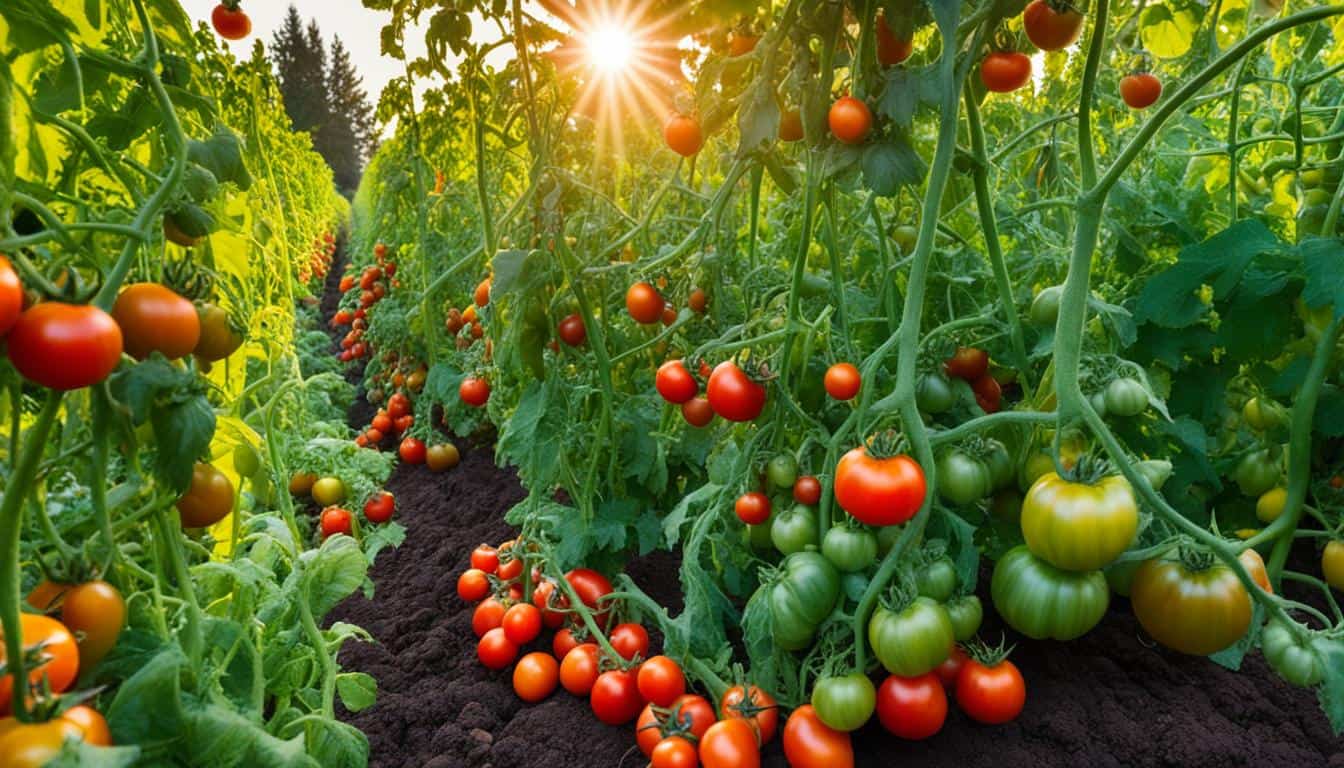
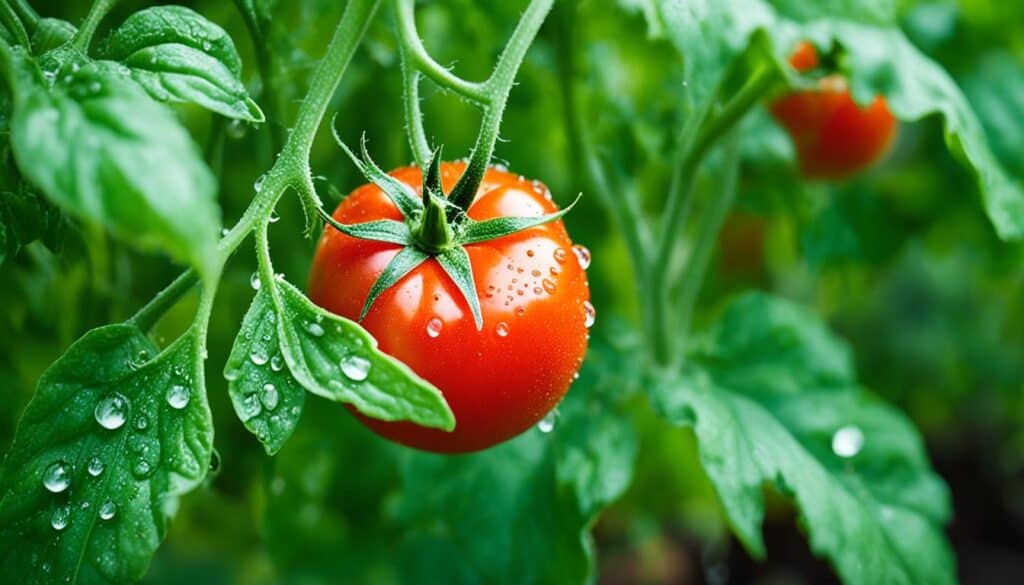
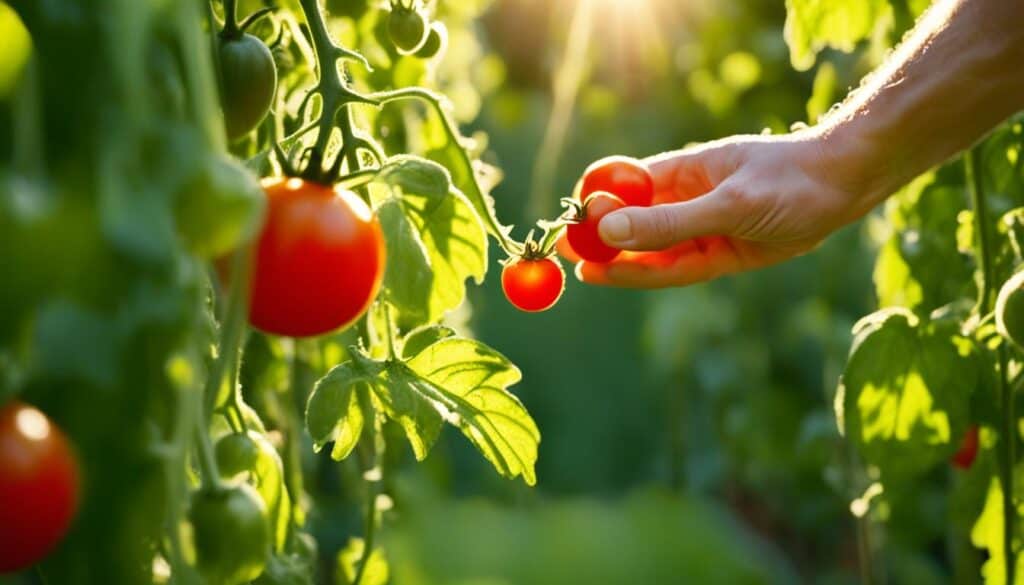

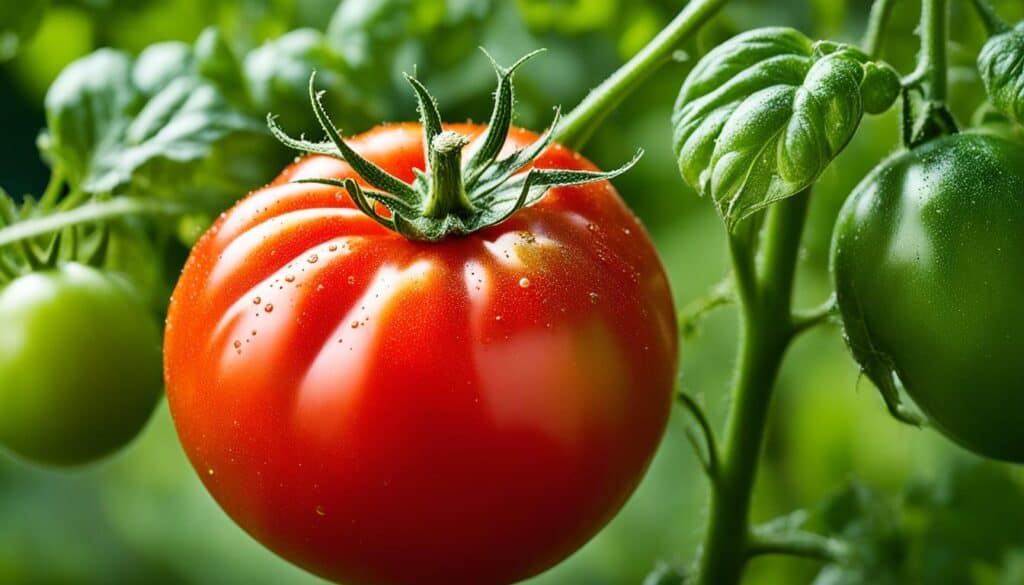
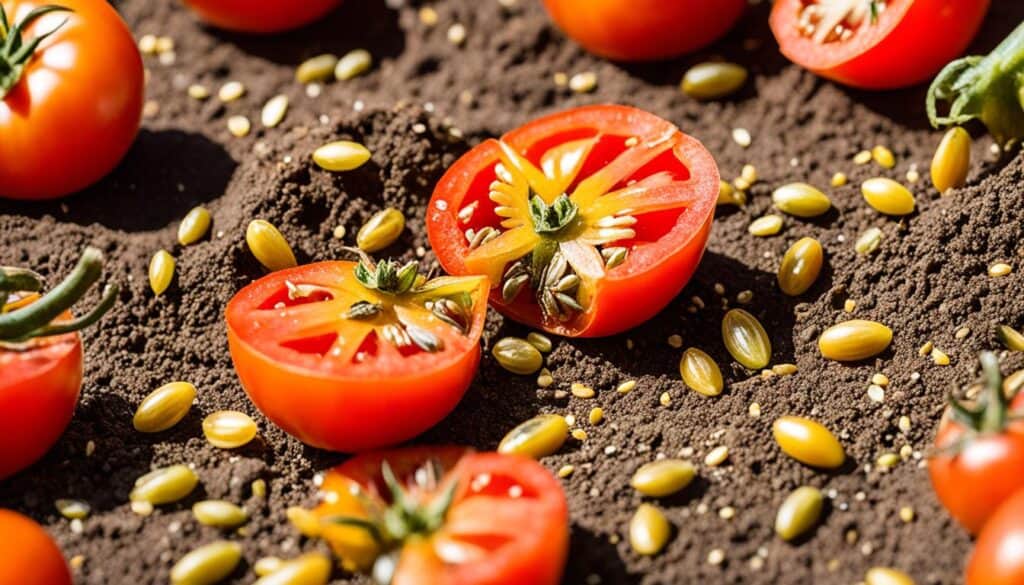



Leave a Reply